Menu

Did you know that food systems globally are responsible for a staggering one-third of all emissions? This startling statistic shows the big role agricultural practices play in our climate. The Paris Agreement is a key global effort to fight climate change. It aims to keep the global temperature increase under 1.5 degrees Celsius.
This agreement focuses on promoting food security and managing climate risks in agriculture. It highlights using eco-friendly farming methods and sustainable development. These efforts are key to control greenhouse gas emissions.
The Paris Agreement is a big step in the battle against climate change. It was started on 4 November 2016. The goal is to stop the climate from changing too much. By doing so, it helps keep agriculture and the economy strong. Understanding this helps the world use less energy and reduce pollution.
The Paris Agreement was set in 2015. Its main aim is to keep the planet from getting too hot. It sets a limit of 2 degrees Celsius, but hopes to keep it even lower, at 1.5 degrees. This is important for farming to stay healthy.
Rich countries must cut their pollution a lot. Poorer countries will try to cut it more over time. Also, there is help for these countries to make this happen.
| Key Milestones | Details |
|---|---|
| Entry into Force | 4 November 2016 |
| Pre-Industrial Level Limit | Well below 2°C; ideally 1.5°C |
| Developed Country Commitments | Economy-wide absolute emission reduction targets |
| Developing Country Encouragements | Enhance mitigation efforts over time |
| Support Mechanisms | For implementing emission reduction targets |
| Global Stocktake | Every five years |
The Paris Agreement has big, long-term dreams. It wants healthy farming and ways to keep the climate cool. Every five years, countries tell their new plans to help. These plans aim for big climate goals by 2030.
This follows the Kyoto Protocol, which had countries lower pollution by 5% from 1990 levels. Now, the Paris Agreement dreams of no pollution at all. This shift would greatly cut the planet’s pollution.
Being careful with the environment brings extra good things, like new jobs and cleaner air. Making these good changes helps soften the effect of climate change. With our planet already too warm, we need to act very fast.
Agriculture is central in talks about climate change. It contributes greatly to greenhouse gas emissions. But, it can also be part of the solution by using sustainable farming.
Understanding the rules that protect our environment is key. These laws affect our natural world in big ways.
The world’s agrifood system causes about a third of all greenhouse gas emissions. That’s 21-37% of these gases each year. Almost half of these emissions are from methane, which is very bad for our planet’s temperature.
Emissions from farms are getting worse in some places. This makes it harder to stop climate change.
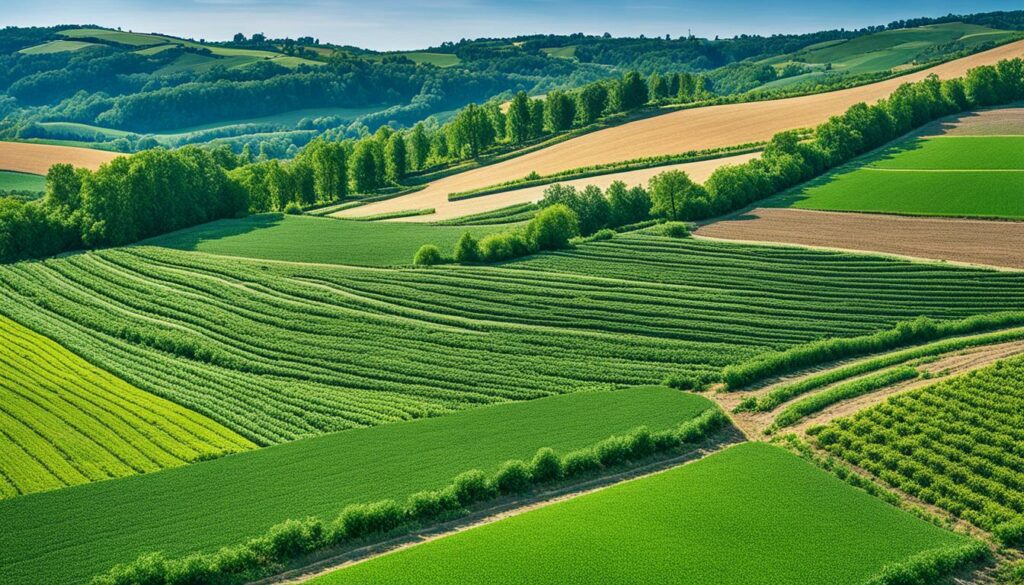
Traditional farming effects go beyond just gases. They hurt our world in other ways, like using too much water. Farming takes up 70% of the water we use.
Soon, with 9.7 billion people needing food by 2050, things will be even more strained. Food lost or wasted is a huge problem. It’s like the world’s third-worst polluter.
Growing farms often means destroying forests. This hurts lots of animals and the climate. Farming is a big part of why our environment is changing, and not for the better.
These changes cause many animals and plants to lose their homes. It makes life hard for them, even putting some of them at risk of dying out.
So, focusing on better farming is urgent. Stronger environmental rules are needed. Together, we can make farming better for the planet. This way, we have a chance to lower its harmful effects on our climate.
Nationally Determined Contributions (NDCs) are key for countries to fight climate change. They show how countries plan to tackle global warming. One big part of these plans is agriculture. This is because farming can help fight climate change and adapt to its effects. So, agriculture plays a big role in the fight against climate change and in keeping our planet healthy.
NDCs are really important for fighting climate change. They show what each country will do to reduce their carbon footprint. In the agricultural sector, they focus on farming better to make sure we have enough food. This includes cutting down on harmful gases and taking care of the environment.
Every nation’s NDCs are meant to be upgraded every five years. This helps keep countries on track with the latest tech and knowledge about climate change. It’s a way to make sure our efforts to protect the planet keep up with the times.
Agriculture is a big deal in the Paris Agreement because it produces a lot of greenhouse gases. In 2014, it was responsible for about 5.2 GtCO2e of emissions. Most of this comes from livestock, crops, and burning land.
Emissions from farming are expected to go up in some countries. To stop this from getting worse, the NDCs have special steps for the agricultural sector.
| Key Area | Description |
|---|---|
| Emission Reductions | Aim to decrease global agricultural emissions by 11-13% by 2030 for the 2°C target and by 30-50% for the 1.5°C target. |
| Adoption of Best Practices | Encourages the adoption of best practices by 10-25% of producers with the lowest emissions intensities to meet reduction targets by 2025. |
| Integration of Supply-Side Mitigation | Predominantly features supply-side mitigation measures with fewer demand-side interventions. |
| Cropland Management | Focused more on cropland management measures compared to grazing-related interventions. |
Many countries are looking at agriculture in their climate plans. For example, nearly 78% of countries are focusing on farming. But only 36% of them have set clear goals and plans for farming. Tools like MOSAICC and GHG-DM are helping with this.
These tools help to show how well countries are doing to meet the Paris Agreement. Others, like the NEXT tool, help countries share knowledge. This means we can fight climate change better and also help our world thrive.
The Paris Agreement is leading the way in changing how we farm. It promotes using new technologies and policies that help farms be more eco-friendly. This change is crucial in fighting the emissions caused by farming, which add a lot to our planet’s greenhouse gases.
Simply put, the Paris Agreement sets goals to cut down emissions. The aim is to make emissions 26-28% less than they were in 2005 by 2025. The Trump Administration pulled back on these goals, but the Biden Administration is working to pick up the pace again. Now, with Biden back in the agreement, there’s hope we’ll try even harder.
The KJWA, along with other groups, is gathering data for the COP, while also looking into how to manage soil and livestock better. This teamwork shows a commitment to making agriculture more sustainable.
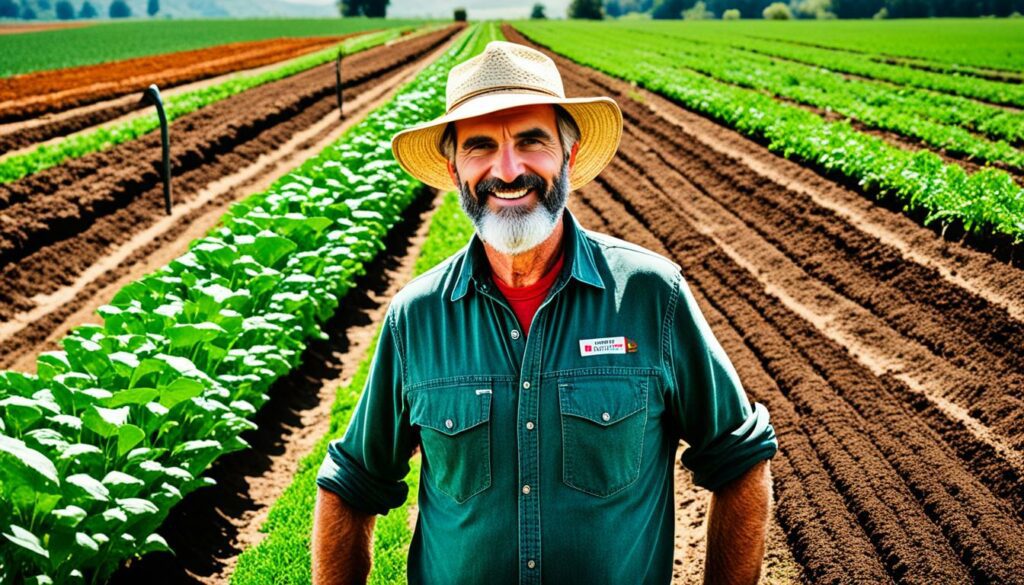
The food we eat creates a third of all greenhouse gases. With more people to feed by 2050, we must farm in a way that’s good for the Earth. A lot of money, almost $3 billion a year, now goes into making farming greener through Climate-Smart Agriculture. But, this area of farming still needs more support to fight climate change.
The World Bank says farming and related sectors help meet the goals of the Paris Agreement. Starting in July 2023, all new World Bank projects must work towards these goals. This shows the big step the world is taking to farm in a way that doesn’t harm the planet.
Some countries, like Bangladesh, Ethiopia, and Ghana, are making special plans to farm smarter. On top of this, unique projects in China and Africa are making food systems that can survive hard times. International groups are also pushing for fair treatment of workers in farming to deal with climate change, highlighting the need for justice in farming.
| Country | Climate-Smart Agriculture Investment Plans (CSAIPs) |
|---|---|
| Bangladesh | In Development |
| Ethiopia | Adopted |
| Ghana | In Development |
Current world events like COVID-19, hunger, and the global climate crisis show us the urgency of acting now. As we move forward, putting eco-friendly farming first is key to creating a better future for everyone.
Climate-Smart Agriculture (CSA) leads the way in facing climate change. It uses new and green farming methods. These methods aim to make farms more productive, help them deal with climate effects, and cut down on harmful gases.
CSA manages various landscapes like fields, animals, forests, and fishing. It tackles the need for food and the impacts of climate. Its main aims are to make farming more productive, robust against climate changes, and less polluting.
CSA looks for wins in more food, farm strength, and less pollution:
The World Bank puts a lot of money into CSA every year, almost $3 billion. It’s also making special plans for CSA in different countries. This helps make the sustainable farming efforts more global and effective.
| CSA Principle | Objective |
|---|---|
| Productivity | Meeting growing food demands through increased efficiency. |
| Resilience | Fortifying agricultural systems against climatic variability. |
| Emissions Reduction | Minimising the carbon footprint of agricultural activities. |
By using CSA, we work towards important global goals. These include ending hunger, making sure everyone has enough to eat, and fighting climate change.
The Paris Agreement promotes farming that is good for the earth. It helps fight climate change by using smart farming. These ways make farming less harmful to the environment and keep our food safe.
Now, many methods are supported by this agreement. They make farms stronger against climate changes and save nature.
Conservation agriculture cares for the soil, water, and plants. It does this by not digging too much, always having something covering the soil, and changing which plants grow each year. This makes farms healthy and keeps them going. The way we grow and get food makes a lot of pollution. But, this kind of farming can help lessen it.
Agroforestry mixes farming and growing trees. This mix means we use our land better in a way that helps us all live off the land. It is very useful with so many people needing food and the world getting warmer. By 2050, we’ll need more food because there will be almost 10 billion people.
Precision farming is all about using the latest tools to farm smarter. It uses things like GPS to watch over the fields and the Internet to control machines. This way, we use less stuff but get more food. It’s really important because wasting food is bad for the planet.
We need to be smart about water because farming uses most of it. Things like drip irrigation and saving rain are important. They save water and make more food. In some places, special plans are being made to use less water but still farm well.
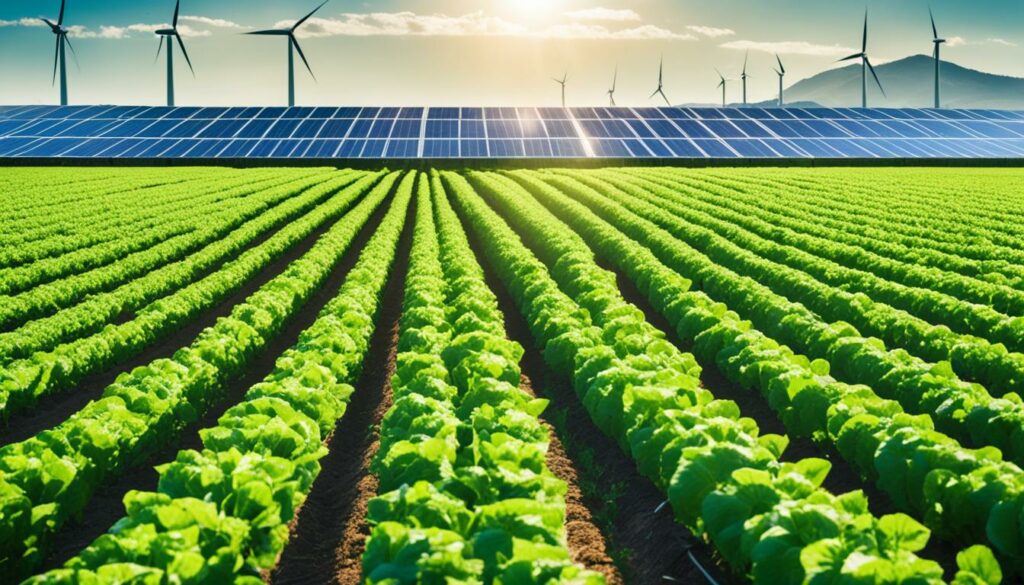
Many places are now farming in ways that respect the Paris Agreement. The World Bank is also helping a lot in this. They put almost $3 billion every year into farming that’s good for the climate. This helps a lot of countries farm in ways that won’t harm the earth.
| Project/Region | Focus | Impact |
|---|---|---|
| Food Systems Resilience Program (FSRP) | Kenya, Comoros, Malawi | Increase food systems’ resilience |
| Climate-Smart Agriculture Investment Plans | Bangladesh, Belize, Burkina Faso, Cote d’Ivoire, and others | Develop and implement strategies for CSA |
| China Green Agricultural and Rural Revitalisation Program | China | Reduce greenhouse gas emissions in farming |
| Agriculture Resilience, Value Chain Development, and Innovation (ARDI) | Jordan | Enhance climate resilience and competitiveness in the agri-food sector |
Using Climate-Smart Agriculture (CSA) in developing nations is key to fight climate change. This sector causes a third of all global emissions. The World Bank now invests almost $3 billion yearly to support these greener farm methods. These efforts not only lower emissions but also make food supplies stronger and more resilient.
Many developing countries are turning to green farming techniques. They’re using crops that can survive climate changes and methods that save water. Even with just 4% of climate funds going to them, investing in these methods is critical. They help meet the Paris Agreement goals and tackle the urgent need for sustainable farming.
Projects in China and Africa show how effective CSA can be. These actions are crucial because our food systems are the top source of methane. They also use a lot of water and cause deforestation in key areas such as the Amazon and the Congo Basin.
The support from groups like the World Bank is helping these countries lead the way in green farming. Pakistan and Jordan, for example, are shining examples. They show local projects really can mix well with global climate and development goals.
It’s key to include farmers who don’t get much climate fund aid in these projects. This way, the most at-risk people can benefit from greener farming methods.
In the end, the challenge is to make farming in developing nations work well with our climate goals. This needs everyone to work together. If we manage this, a future awaits where farming is both productive, green, and resilient.
Technological innovations play a key role in making farming sustainable and eco-friendly. The global food system accounts for one-third of all emissions. By 2050, it will need to feed 9.7 billion people. So, using advanced tech in agriculture is more important than ever.
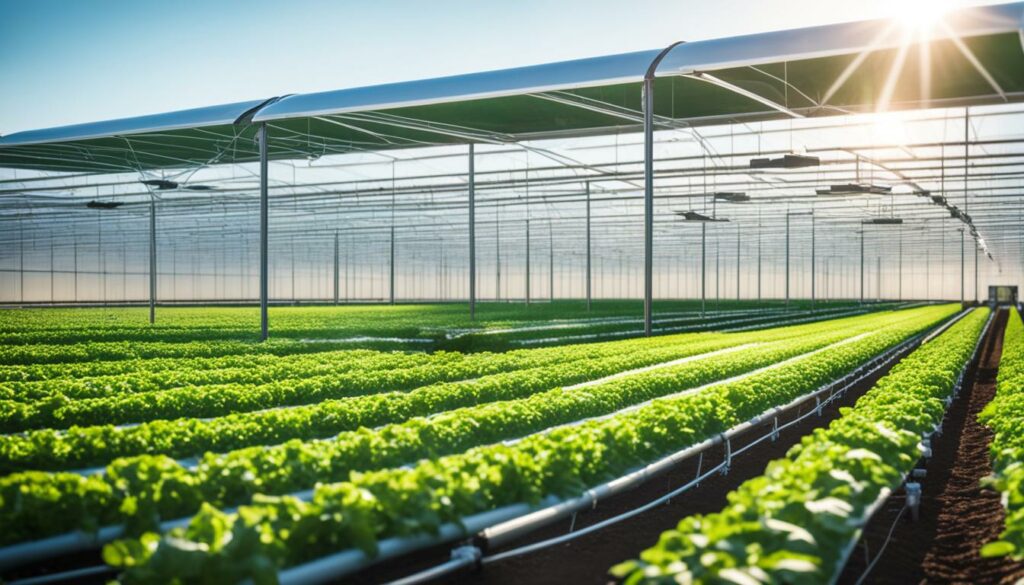
Technology is crucial in reducing the environmental impact of farming. Food systems use 70% of the world’s fresh water. They are also a significant source of methane and cause biodiversity loss. Introducing new agricultural technologies can help move the sector towards sustainability. For example, the World Bank is investing nearly $3 billion each year in Climate-Smart Agriculture (CSA). This is boosting eco-friendly farming practices worldwide.
Many new technologies are making a big difference in agriculture. They include crop varieties that can survive harsh weather, reducing crop losses. Precision farming tools save resources and lower waste. These actions are key because the food system is a top global emitter. And, new techniques for managing soil and water are also cutting down on environmental harm.
Big global projects show how technology can benefit agriculture. For instance, the $200 million Punjab project focuses on inclusive agriculture. And the $345 million China program boosts productivity and sustainability. There’s also the $13 million CropLife International project, which helps manage pests in an eco-friendly way. Over the past 25 years, thanks to these efforts, more than 300 million tonnes of CO2 were kept out of the air.
| Project | Investment Amount | Focus Area | Impact |
|---|---|---|---|
| Punjab Resilient and Inclusive Agriculture Transformation Project | $200 million | Inclusive Agriculture | Enhanced resilience and sustainability |
| China Green Agricultural and Rural Revitalisation Programme | $345 million | Rural Revitalisation | Improved productivity and sustainability |
| Food Systems Resilience Programme for Eastern and Southern Africa | $621 million | Food Security | Strengthened food systems |
| Agriculture Resilience, Value Chain Development, and Innovation Programme in Jordan | $125 million | Agricultural Value Chain | Innovative farming practices adopted |
It’s clear: new tech in farming is crucial for our planet and its future. By using and spreading these eco-friendly farming practices, we can cut the harm farming does to our environment. But we can also make sure there’s enough food for all, now and in the future.
Getting money to help sustainable farming is crucial. It helps grow these methods under the Paris Agreement. There are many ways to get funds to meet these big goals.
The Paris Agreement opened up many ways to get funds for sustainable farming worldwide. The Green Climate Fund is key, as it provides a lot of money to help apply smart climate practices. It started with over $3.1 billion for 141 projects. There were more than 1,000 ideas, asking for over $20 billion in total.
In the first round, $2.8 billion went to 70 projects. They asked for $5 million to $100 million each. Another $325 million was shared among 71 projects from the $2 billion in total proposals.
Global groups play a big part in getting money for sustainable farming. They work with over 30 special institutions and more than 20 tribal groups. This helps bring many new ideas to life. Nearly 100 universities help out by sharing their knowledge. For example, the Inflation Reduction Act gave $3.1 billion to help USDA loan relief. And another $2.2 billion went to help farmers who were treated unfairly in USDA loan programs.
Many successful stories show how funding supports farming. Investments have opened new markets and brought more than 60,000 farms into using smart climate practices. They’ve also helped take out over 60 million metric tons of harmful gases from the air.
Some of the biggest wins come from projects run by groups not always heard. For instance, 11 projects by Historically Black Colleges/Universities (HBCUs) and six by Hispanic Serving Institutions (HSIs) show what focused money can achieve.
| Initiative | Amount Allocated (Billion $) |
|---|---|
| Environmental Quality Incentives Program | 8.45 |
| Regional Conservation Partnership Program | 4.95 |
| Conservation Stewardship Program | 3.25 |
| Agricultural Conservation Easement Program | 1.4 |
| Conservation Technical Assistance Program | 1.0 |
Bringing the Paris Agreement’s agricultural goals to life is tough. The aim is to keep global heating under 2 degrees Celsius, ideally at 1.5. This path is littered with challenges.
Farmers often don’t know enough about green farming under the Paris Agreement. They need to learn about ways to farm that help the climate. Teaching them about eco-friendly methods is key.
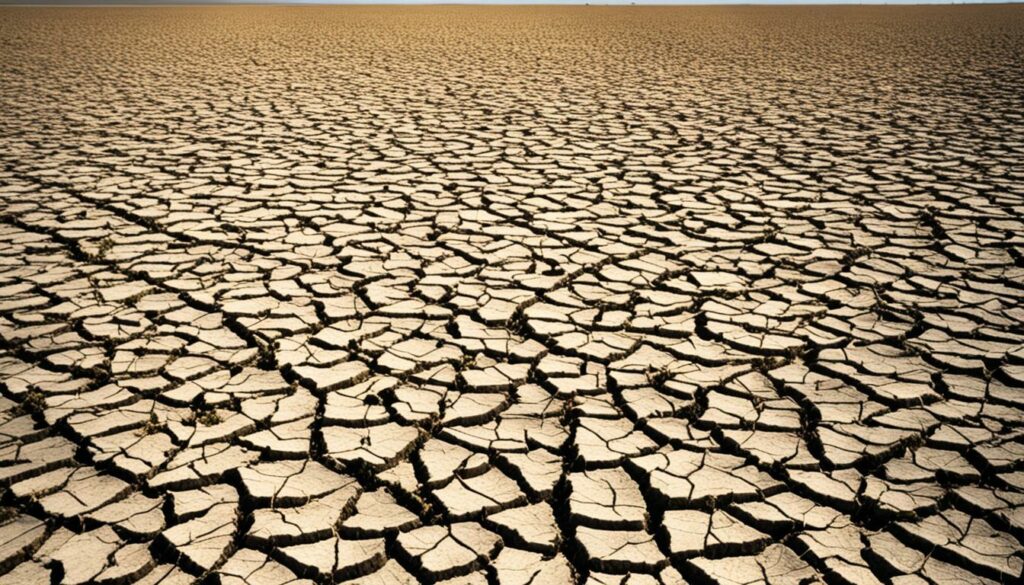
Adopting climate-smart farming is hard because of a lack of money and materials. By 2050, the world will have around 9.7 billion people to feed. But, big money flows mainly to other climate efforts, leaving farming short. We need more cash going to farming to help farmers.
Changing how we farm needs big policy changes, not just new tools. Getting the right laws and support for green farming is critical. But, politics and business often slow or weaken these laws, working against the Paris Agreement. Everyone, from governments to local groups, needs to come together to clear these hurdles.
Strategies in farming help us fight climate change and meet Paris Agreement targets. I’ll look into these methods, showing their global benefit in farming.
A big goal of these strategies is to cut down on harmful gases. They focus on things like carbon sequestration. This is when we use soil practices to catch and store carbon dioxide. The advice to do this came in 2007 from the Intergovernmental Panel on Climate Change. This idea is key to today’s efforts to fight climate change.
Improving how we look after our animals is also vital. Back in 2012, the American Farm Bureau Federation showed the need to lower methane from animals. Another cool idea is using “green” ammonia in fertilisers. This makes agriculture less harmful, which the Council for Agricultural Science and Technology talked about in 2011.
Adaptation efforts make farming stronger against changing weather. They focus on keeping water and soil good and making sure crops don’t change too much. The work done in the 25x’25 Adaptation Initiative in 2013 makes all this clear. It’s important for helping farmers deal with changing weather.
Having systems that warn us about bad weather early has been a big help. This way, farmers can protect their crops better. The Proceedings of the National Academy of Sciences in 2007 say we need more tech like this to stay ahead of climate change in farming.
Around the world, examples show us these methods work. For instance, the Midwest in the US has more wheat thanks to smart adaptation. And they’re cutting emissions in the corn and soybean fields with mitigation. This shows how both are needed to improve agriculture.
Global work helps, too. The United Nations’ 2012 food security report says many are using crops that can handle climate changes. The Iowa Corn Growers Association in 2011 also notes the power of local actions in the fight against climate change.
| Strategy | Actions | Organisations Involved |
|---|---|---|
| Mitigation | Soil Carbon Sequestration, Improved Livestock Management | IPCC, American Farm Bureau Federation, Council for Agricultural Science and Technology |
| Adaptation | Water Availability, Early Warning Systems | 25x’25 Adaptation Initiative, USDA Climate Hubs, Proceedings of the National Academy of Sciences |
| Success Stories | Climate-Resilient Crops, Water-Saving Techniques | United Nations, Iowa Corn Growers Association |
The mix of these two sets of strategies in agriculture is powerful. Success stories from around the world show this. As efforts grow, our farming future looks brighter and more prepared for climate change.
When we talk about keeping agriculture going in a sustainable way, policy and governance are key. They guide the work and success of efforts towards farming that won’t harm the planet. This is done in line with goals that everyone has worldwide. Let’s see how each country’s policies and global agreements make a big difference.
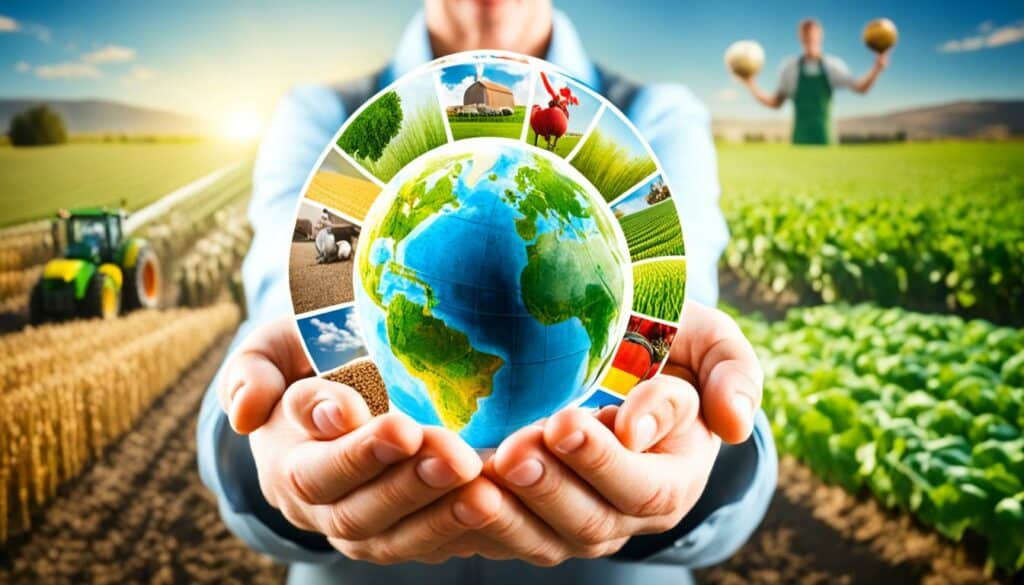
To make sure agriculture is sustainable, countries need strong rules. These rules push for eco-friendly ways of farming. Leaders all over the world are coming up with ways to make farming kinder to our planet. They’re doing this because farming is a big part of why our environment is suffering. It makes a lot of the pollution and uses most of our clean water. One day, we’ll need to grow even more food to feed over 9 billion people. So, these rules must deal with these big issues.
Countries also need these rules to get money and help for dealing with climate change. Take the example of the World Bank. It now gives a lot more money, nearly $3 billion every year, for smart farming that helps fight climate change. This money helps countries make plans to farm in ways that don’t make as much greenhouse gas. So, these rules and the money help move farming in a better direction.
Worldwide efforts and deals are also very important for green farming. One big programme is the United Nations’ work on climate and farming. Through this, countries can learn from each other about good farming methods.
The World Bank helps with projects to make farming stronger. Like in Africa, they have a programme to make sure food is still available even when the weather is bad. All these efforts and agreements make sure the World Bank’s projects stick to the goals we set in Paris. This makes sure the whole world is working together for better farming.
All these actions show how important it is for countries and international groups to work together. With the right rules and everyone helping out, we can meet the big needs of farming without hurting our planet. This is how we prepare for the future.
Under the Paris Agreement, farming is changing in big ways. It’s moving towards goals like cutting down on harmful emissions, building strong food systems, and coming up with new ideas in farming. These changes are key to what lies ahead in agriculture.
The future of agriculture is tied to big goals for cutting emissions. Right now, farming produces a big chunk of the world’s emissions. It has to change to meet the food needs of nearly 10 billion people by 2050. Plans include ways to farm that use less water, don’t harm forests, and produce less harmful gases.
Almost no climate money goes to farming, and very little of that helps small farms. More focused money is needed for farms to go green. Money from the World Bank for Climate-smart Agriculture (CSA) is growing, hitting nearly $3 billion each year. This bigger investment shows a serious move towards greener farming. World Bank projects now must follow the Paris Agreement, showing how policy is crucial for new farming ideas.
The future of farming will see big changes with new tech and ideas. Things like farms in cities, more precise farming, and eco-friendly products will help a lot. Plans are in place to spread these new ways of farming to countries like Bangladesh and Morocco.
Places like China and parts of Africa get special focus from the World Bank to make farming greener and stronger. A project in Jordan aims to help many farm families grow food in better, less harmful ways. It also plans to make more jobs and help sell more products.
Another big part is global efforts like the Koronivia Joint Work on Agriculture (KJWA). This group helps countries and farmers learn and share new ways to fight climate change and get stronger. It’s a big step towards a healthier, more stable farming future.
All these moves in money, laws, and technology paint a bright picture for farming under the Paris Agreement. They show a path to a better, more sustainable way of growing the food the world needs.
The Paris Agreement changed how we farm worldwide, making big steps to lower the carbon footprint of the sector. Greenhouse gases from farming make up 9 percent of America’s emissions. Sadly, these have risen by 11 percent since 1990. Over 80 percent of countries are working to cut these emissions. They aim for more sustainable farming because of this important agreement.
Big climate events like the 2014 drought in California and the western U.S. caused $4 billion in damage. It showed the urgent need for farming to adapt. Droughts in Texas and the Great Plains in 2012-2013 led to over $41 billion in losses. These events underline the high costs, both economic and environmental. Soil management plays a big role in emissions, with stored carbon being released. Using better strategies, including those from the EPA, is key.
Using smart ways to manage land, crops, livestock, and manure can cut methane, a gas much more harmful than carbon dioxide. To meet the temperature rise goals of the Paris Agreement, countries must do more than they have promised. Policies set during COP26 in Glasgow and the growth in carbon offset markets show the important role of rules and management in reaching these tough targets.
In the end, good policies, governance, and new farming methods can change agriculture for the better. They can help make the world’s farms more sustainable and ready for climate changes. The work set by the Paris Agreement points us to a future with eco-friendly farming and less of climate change’s bad effects.
The Paris Agreement is a pact signed in 1992 to handle climate change. It aims to keep global temperatures from rising too high. Long-term, its goals are to limit the rise to less than 2 degrees Celsius.
It also aims to help secure food and support economies in a green way.
Farming plays a big part in greenhouse gases. It emits lots of methane and leads to deforestation. These actions add majorly to our planet’s emissions.
It also affects how much food we can grow and natural diversity.
NDCs are promises made by countries to cut down on climate harm. Most developing nations aim to reduce their emissions by focusing on farming and land changes. This shows how significant farming is for tackling climate issues.
Climate-Smart Agriculture improves farming in several ways. It raises how much food we can grow. At the same time, it makes farms tougher against the changing climate.
This kind of farming also helps to lessen the harm we do to the environment.
The Paris Agreement backs certain types of farming. These include things like keeping the soil healthy and using water smartly. It also encourages planting trees among crops.
These methods help use fewer resources and lower the amount of pollution farms make.
Developing nations are taking up Climate-Smart Agriculture. They use special crops and water-saving methods. This helps them keep producing food even as the climate changes.
They also focus on using technology to farm more precisely and productively.
New technologies are key for greener farming. They include tools for farming more accurately and better seeds. These tech advances are vital for keeping farming green and effective.
The Green Climate Fund and help from global groups offer money for eco-friendly farming. This funding allows countries to use the latest farming methods. It helps them make more food while using fewer resources.
The main hurdles include not enough knowledge, not having the money needed, and facing tough political and economic situations. To truly achieve greener farming, we must tackle these hurdles.
For fighting climate change, we have practices like keeping more carbon in the soil and better ways to care for animals. For adapting to the climate, we can use technology to predict bad weather and grow hardier crops.
These efforts make our food supply stronger and help farming withstand the effects of climate change.
Strong laws and worldwide projects, such as the UNFCCC’s Koronivia Joint Work on Agriculture, are important. They help make sure farming supports the goals of the Paris Agreement. This keeps our food-growing practices in line with keeping the planet healthy.
Going forward, we might see more innovations in farming, such as farming up in the air or new types of fertilizers. The goal is to farm in ways that help the climate and make us less dependent on harmful practices.